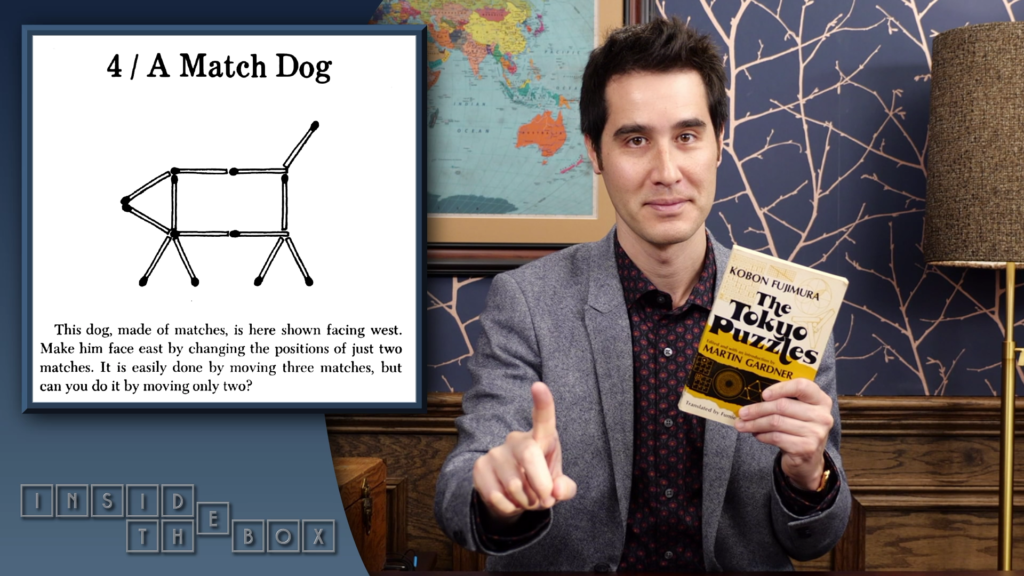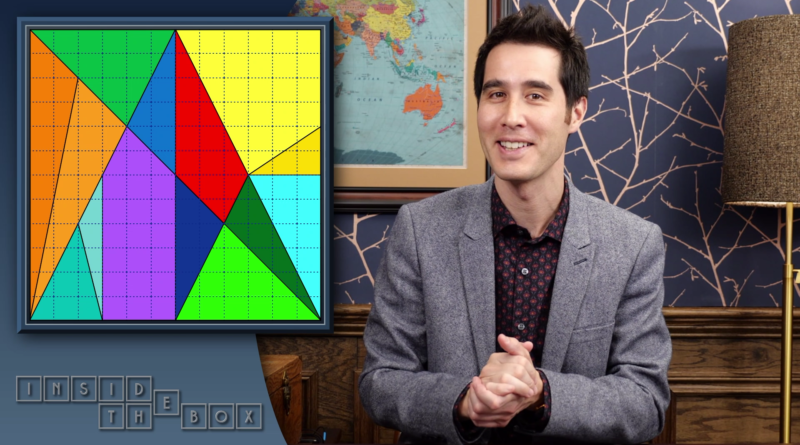INTERVIEW: David Kwong has a puzzle or two up his magician’s sleeve
Photo: David Kwong performs in the Geffen Stayhouse world premiere production Inside the Box. Photo courtesy of Geffen Playhouse / Provided with permission.
David Kwong has two impressive jobs on his business card: magician (cool) and puzzle maker (doubly cool). In his career, he has constructed crosswords for The New York Times, offered TED Talk presentations, sold out his off-Broadway show called The Enigmatist, and garnered praise from audience members and industry experts alike. His performative art hit a few road bumps with the COVID-19 pandemic, and his West Coast transfer of The Enigmatist was delayed indefinitely. But he has found a way to soldier on.
And now the Geffen Playhouse, which was to host The Enigmatist in Los Angeles, has joined with Kwong for a new virtual puzzle show called Inside the Box. Performances began recently, and tickets quickly sold out for the entire run through January. Future dates may be released soon.
“My show The Enigmatist from New York, which did quite well, was a big hit and a sellout,” Kwong said in a recent phone interview from his Los Angeles home. “It closed in January of 2020 in New York, so it was set to premiere here at the Geffen in May 2020. And we then kept getting pushed back and pushed back, and obviously the world hit pause. When quarantine started I just for fun started goofing around on Instagram Live and doing a split-screen Instagram Live with celebrities. They would come on, and I would hold up my iPad with puzzles. … What I noticed is that everybody watching in the comment section was typing in their answer as quick as possible. I realized that this was a fun group activity, and I set out to put this into a longer format. And the Geffen approached me about producing it, and here we are with Inside the Box.”
Very much like seeing a whodunit mystery, it’s best to leave the puzzles that Kwong offers throughout the evening a secret. Like a good magic show, the word plays are best experienced with novel eyes. What audience members do experience during the 90-minute show on Zoom is a decked-out production design that is fun, interactive and clever. Kwong broadcasts live from his home office, sitting behind a desk like a late-night talk show host. Everyone in the audience can be seen in their own Brady Bunch-style squares, and there are even times when a Zoomer will be kicked up to a special bubble to reveal the answer to a puzzle.
“It was an enormous amount of work,” Kwong said about the production design. “I have to give credit to all the people that did the heavy-lifting on that. Josh Higgason is our video designer, and Brett Banakis is our creative director. Those guys are incredible. They both worked with me on The Enigmatist in New York, and Brett Banakis in particular he is a Broadway production designer. He worked on Harry Potter and the Cursed Child. Everyone was learning a new ecosystem here, so it was months of sitting in front of a camera and several computers. The Geffen built a set in my house here in my downstairs office, and it took a lot of troubleshooting. You know what, it’s not perfect, but it works for everybody.”
In the few times when the show is not perfect, it’s probably that the sound cut out or an audience member’s microphone isn’t turned on. Inside the Box is at the mercy of wifi signals and internet reliability. That said, this reporter’s performance saw no glitches or mishaps. The show ran smoothly and without interruption.
“Everybody understands this is the ecosystem we’re in,” he said. “At the end of the day we pull it off. Everybody has fun solving the puzzles, and it’s a great time. I just wanted to add, I like to say we hacked Zoom. We figured out a way to overlay it with dynamic graphics, so that people are popping up in bubbles. They’re solving things in rows of five. We’ve really turned it into a dynamic game show.”
Definitely there are many attributes that set Inside the Box apart from other Zoom shows. For starters, the microphones of audience members are encouraged to stay on throughout the show. That means as Kwong is performing and relaying stories about historic puzzle makers, one can hear reactions from fellow theatergoers — almost as if this virtual environment were a real live theater. (Remember those.) This audio setup also means barking dogs can be heard in the background, and sometimes a spoil sport will reveal the answer to a puzzle. On the night this reviewer saw the show, Kwong had some friends in the virtual crowd, and they cheered on their buddy behind the desk.
“For the most part everybody keeps that under control, and we have a house management team that is looking for Zoom boxes that might be too loud,” Kwong said. “I do want it open. I want it dynamic. I want it energetic. I encourage people to interrupt me. It’s really, really great when I pop somebody up to answer a question, and instead of going right into the question, they say, ‘Hey, I’ve just got to tell you, I solved this puzzle the other day, and it was really great.’ So people are telling me their puzzle stories. They’re Zooming in from Brisbane, Australia, and Italy and all over the U.S. It’s just the best community of people that’s excited to puzzle. The word nerds are coming out. We leave the mute off. We allow people to engage as much as possible.”
Kwong’s own internet connection has been 100 percent throughout the run of the show. The Geffen upgraded the service in his house, and he’s hard-lined right into the web (no unreliable wifi for him). If someone’s internet skips out for a few moments, no worries. The puzzles are quick and not too time sensitive. Missing one element will not ruin the entire evening.
“So if you miss something I’m saying for half a second, it’ll catch up,” he said. “I think that might be hard in a magic show. … That’s the other hat that I wear, where if you miss that sleight-of-hand move, the show changes. I think here the way it’s laid out, there are questions that you can catch up on if something slows down.”
Why make a reference to a magic show? That’s because Kwong has earned credibility among both puzzle makers and illusionists. He called the combination of both art forms the “whole thesis” of his career. In the end, he believes the best magic tricks are puzzles that need to be solved, but of course like a good illusionist he’s hoping some of the tricks are never quite solved by the audience. There still needs to be mystery at the end of the night.
“One of the people that I reference in my show is Martin Gardner, and he was famously a magician as well as a puzzle maker and mathematician,” Kwong said. “There’s so much crossover for these exercises that challenge your brain, that ask you to figure out what’s going on. There are some puzzles in my show that should make you scratch your head on how did that work.”
On the topic of accessibility, for Kwong, the world of puzzles is a welcoming one no matter someone’s individual skill level. He likes to quote his friend and fellow puzzle maker David Shukan, who is listed as puzzle designer for Inside the Box.
“He and I collaborated heavily on the architecture of this show, and he’s an example of somebody who lives and breathes puzzles,” Kwong said. “I’m very good at creating puzzles that are performative and accessible and for people of all levels. … I personally think that a good puzzle is like a good magic trick. It’s a story. It lays out the rules, and then it takes you down a path. And then it might twist things on you and misdirect you for just a moment before you figure out what’s going on. In a good puzzle there should be an ‘a-ha’ moment when the audience member goes, of course, that’s what’s happening. Will Shortz, whom I reference in the show, the puzzle editor of the [New York] Times, I always reference what he says about the ‘a-ha’ moment. The ‘a-ha’ moment is when your solver figures out what is going on, and two things happen at the same time simultaneously. The solver feels smart for having cracked the code, and they also acknowledge how clever the puzzle maker is for having come up with the ruse to begin with. So there’s that symbiotic relationship between the puzzle maker and the puzzle solver in that ‘a-ha’ moment.”
Now it’s up to audience members at Inside the Box to figure out the ruse.
By John Soltes / Publisher / John@HollywoodSoapbox.com
Go check out Inside the Box, by David Kwong, which is now playing virtually via the Geffen Playhouse in Los Angeles. Performances through January are currently sold out, but future tickets may be released. Click here for more information.
P.S. Can you spot the puzzle within this journalism article?


